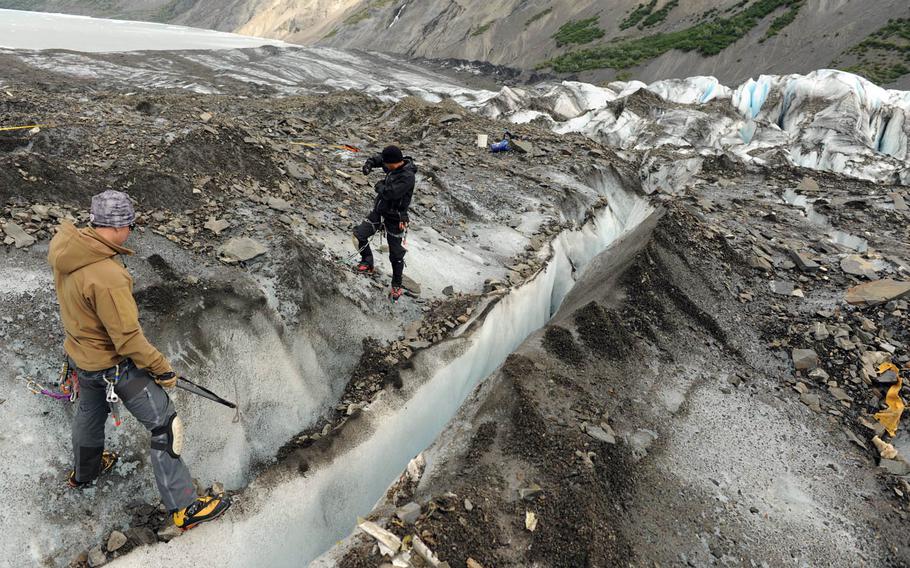
Searchers on Alaska's Colony Glacier anchor themselves to the glacier wall before attempting to search for possible evidence of the 1952 Air Force C-124 crash in a crevasse, June 30, 2013. (Clifford Bailey/U.S. Navy)
The Federal Aviation Administration has placed a five-month flight restriction over an Alaskan glacier to prevent sightseers from disturbing debris and human remains from an Air Force plane crash in 1952 that killed 52 people.
Recovery missions on Colony Glacier during the past four summers have repatriated the remains of 35 crash victims of the C-124 aircraft.
The unprecedented flight restriction, which begins Friday and ends Oct. 15, extends one nautical mile around the tip, or “toe,” of the glacier, according to an announcement from Alaskan Command, which had requested the FAA action.
The flight restriction came after reports of sightseeing helicopters landing on the glacier.
“We’ve been doing this recovery effort since 2012, and this is the first time that we’ve been notified that sightseeing is taking place out there so that’s why we initiated this action,” said Tommie Baker, an 11th Air Force spokesman.
Officials were concerned that human remains might be disturbed and artifacts removed.
Air Force Mortuary Affairs Operations is the lead agency in the recovery missions, with Alaska Army National Guard and 673rd Air Base Wing providing logistical support, said Master Sgt. John Gordinier, an Alaskan Command spokesman who has been involved with the missions since they began.
The C-124, with a crew of 11, crashed during a flight from McChord Air Base, Wash., to Elmendorf Air Force Base near Anchorage. The cause of the crash was never determined. The unsuccessful search at the time for the missing plane could not begin until three days after the crash because of severe weather.
In June 2012, an Alaska National Guard helicopter crew discovered debris on Colony Glacier, which empties into Lake George. A team sent in to investigate found items belonging to the long-missing C-124.
Later this month, searchers will fly over and assess the crash site, which will help them plan this summer’s mission, Gordinier said. The glacier steadily thrusts up some debris, while pulling under other parts.
Meanwhile, the glacier moves toward the lake at 5 to 30 feet per year, with massive chunks calving off and dropping into the water.
There is only a small window of time each year, usually in June, when conditions are safe enough to search, Gordinier said.
There have been reports, yet to be confirmed by overflights, that there is now a 20-foot-wide crack in the glacier near the toe, which is the end nearest the water, Gordinier said.
“There are constant earthquakes on the glacier because it’s always moving,” he said.
Other perils include crevasses up to 100 feet deep, holes created by melting water, ice shards as sharp as glass and weather conditions that can drastically change in a matter of minutes, he said.
olson.wyatt@stripes.com
Twitter: @WyattWOlson